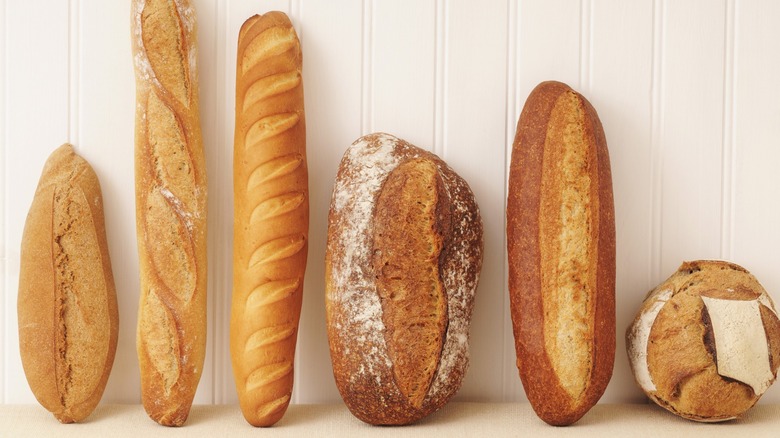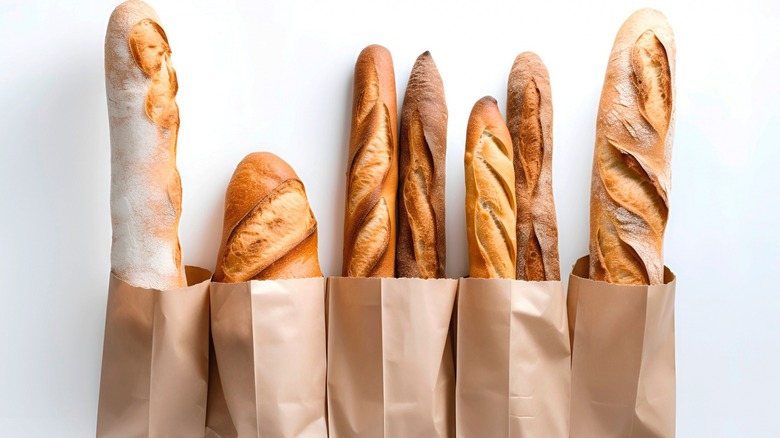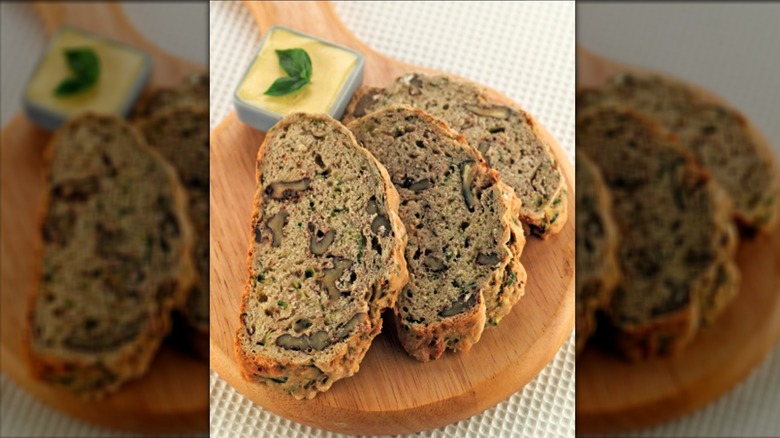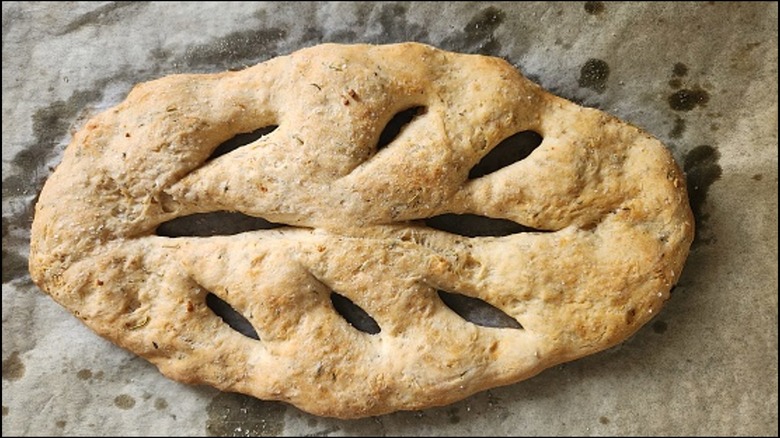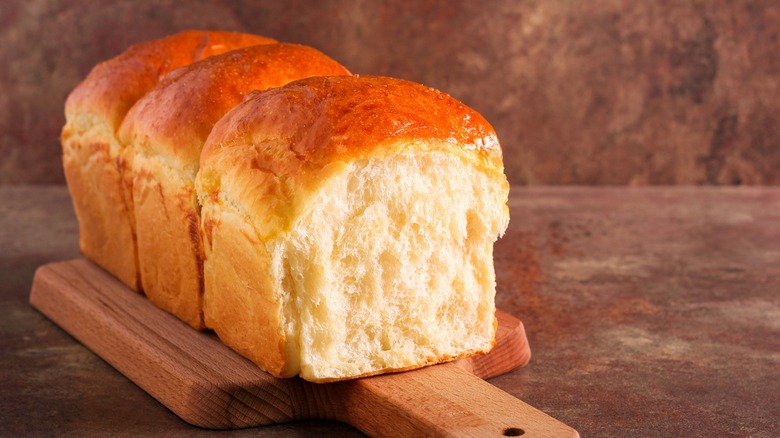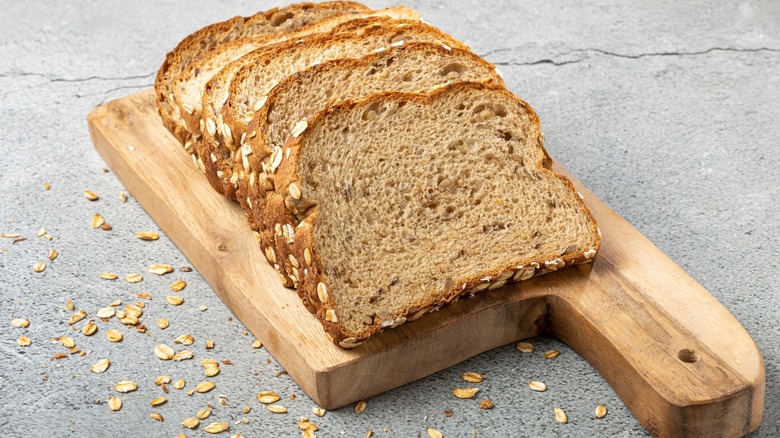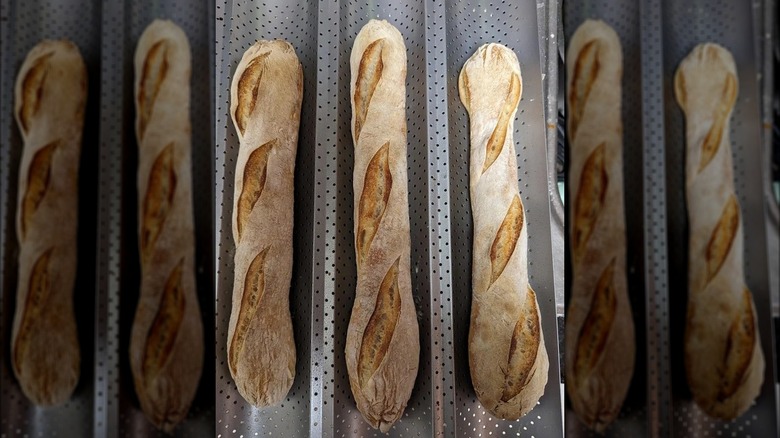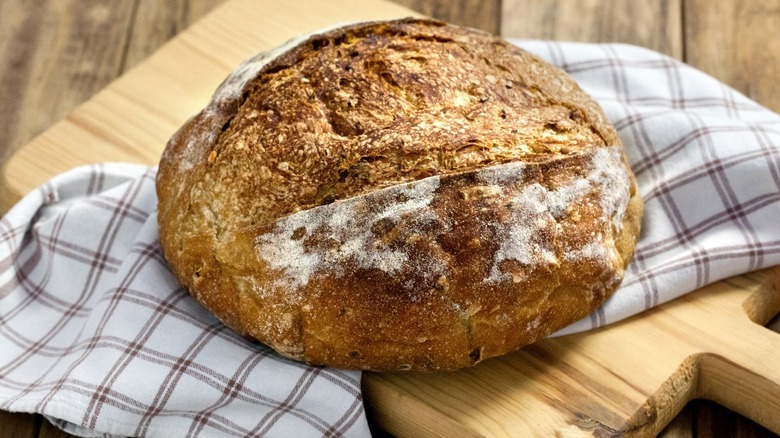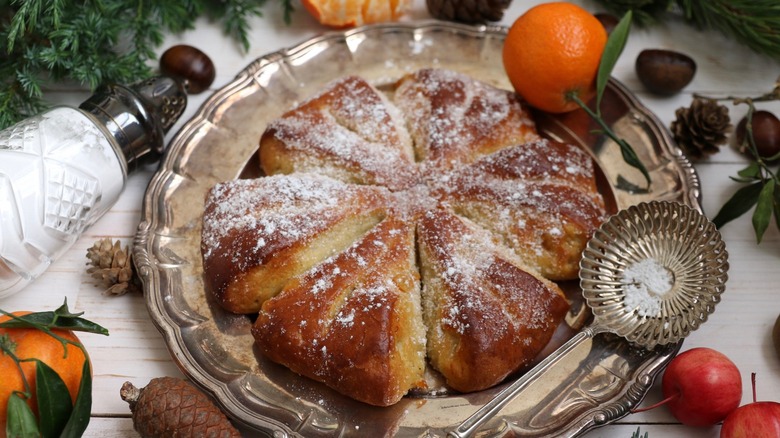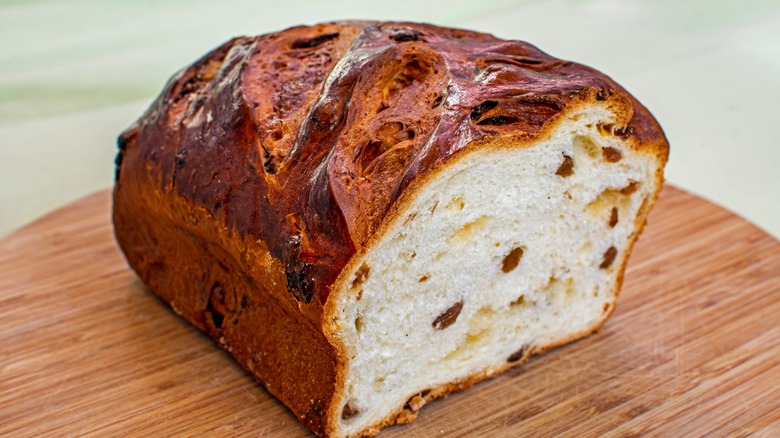12 Types Of French Bread And How They Are Different
If the French are known for one thing, it's their bread, which is called pain in France — and their bakeries, known as boulangeries. With so many different types of French bread around, it can be a bit confusing figuring out what type to buy, whether you're on a trip to Paris or simply shopping in your local artisan bakery.
Even if you think you're knowledgeable about French bread, do you know your baguette from your brioche and your fougasse from your ficelle? Can you tell the difference between pain couronne, gibassier, and cramique? If not, there's no need to worry.
We'll ensure you're a bread expert on your next bakery trip as we take a look at 12 types of French bread, from pain de campagne to pain complet. We'll explore the origins of each type of bread, how it's made, how best to enjoy it, and anything else you could ever need to know.
1. Baguette
We're kicking things off with probably the best-known French bread. Quintessentially French, around 10 million baguettes are sold in France every year, and the French stick, as it's also known, certainly has an interesting history.
The baguette didn't get its name until the 1920s, and to this day, it must be made in a certain way to be classed as an authentic baguette. Le Décret Pain, or The Bread Decree, was passed in 1993 to ensure all baguettes are sold in the bakery where they're made, are made by hand, and only include four ingredients: Salt, yeast, wheat flour, and water.
Of course, there are some variations on the traditional baguette, too. Step into any bakery in France, or a good French bakery in cities worldwide, and you'll likely find baguette au sésame, with sesame seeds, aux olives, with olives, and aux céréales, with grains and cereals, amongst others.
What's the best way to enjoy your baguette? Serve it for breakfast as the French do, slathered in butter and dunked in hot chocolate or try it with almost anything, from cheese and ham to soups and sauces. It also makes a great sandwich.
2. Pain au Noix
Pain au noix, which translates as nut bread, is a delicious French bread that's traditionally made with wholewheat or all-purpose flour, yeast, salt, and ground or chopped walnuts. The recipe is thought to date back to the Middle Ages when it was common to add nuts to bread. Some variations on the recipe use pecans or hazelnuts instead, and honey and spices may be added to the dough, depending on the baker's preferences.
Pain au noix is particularly popular in the South of France, where walnuts are grown. The best thing about French nut bread is its crunchy texture and deep, nutty flavor. This makes it the perfect complement for a whole range of savory and sweet dishes. In France, you'll often find it served with charcuterie, cheese, and wine. It also tastes delicious with jam or honey and makes great sandwiches when filled with cheese and cured meats.
3. Pain de Campagne
Pain de campagne, which literally translates as country bread, is, as its name suggests, a rustic, hearty loaf that may not be the most attractive bread in the bakery, but it more than makes up for that with its tangy flavor. The story goes that rural French villages would bake huge loaves weighing up to 12 pounds in communal ovens. The loaves, made with each family's own dough, could feed their families for weeks. Also known as pain paysan, or farmer's bread, pain de campagne is made with sourdough starter and a combination of whole wheat and white flour.
Crusty on the outside, with a chewier texture than a baguette, French country bread comes in a variety of different shapes, but all are usually quite irregular. Round or oval-shaped loaves seem to be the most common. The tangy sourdough flavor is delicious with cured meats and cheeses. It also makes excellent toast or sandwiches. However, a really good pain de campagne calls to be simply sliced, toasted, and slathered with French butter.
4. Fougasse
Think of fougasse as a French take on focaccia. With its chewy crumb and light, spongy texture, it's packed with flavor from the fresh herbs and salt added to the dough — usually thyme, rosemary, and sage. Fougasse is normally shaped like a large leaf and takes its name from the Latin word for focus. Though some will argue that it originated in Provence in South East France, it actually has its roots in ancient Rome.
The Romans cooked a flatbread known as panis focacius in a wood-burning oven. It's said they used the flatbread as a kind of test to see how long dough would take to bake and how hot the oven was.
In France, fougasse is often served as a snack or appetizer and is commonly placed on the table alongside a variety of dips. Some varieties of fougasse include cheese, olives, or even dried fruit, and it can be either sweet or savory.
5. Brioche
Though many French breads feature a crunchy outer crust, there's one that's very different. Brioche isn't really cake, but neither is it bread — instead, it's a delicious combo of the two, with a rich flavor that's not unlike sweet cake.
Made with butter, milk, and eggs, it has a sweet taste and velvety texture. Some bakeries add crème fraîche to the mix for an even lighter, fluffier loaf. In France, you'll commonly find brioche eaten for breakfast — French children love the tiny brioche buns studded with chocolate chips.
Brioche comes in a variety of different shapes, from a simple loaf to a plaited version and even burger buns. A brioche loaf is perfect sliced for french toast, while the sweetness of brioche buns complements juicy, meaty beef burgers perfectly.
If you want to try making brioche yourself at home, it's actually one of the easier French breads to make. You can add almost anything you like to it, too, from chocolate chips to vanilla or citrus zest to sugar-coated almonds.
6. Pain Complet
The next bread on our list is one that's found in almost every country in the world, but somehow, the French just make it taste so good. Pain complet, sometimes called wholemeal bread, is traditionally made with a mix of wholewheat and white flour, though some bakeries simply use wholewheat flour. Where 100% wholewheat flour is used, the resulting bread may be called pain integral.
This filling loaf has a dense texture and nutty flavor from the wholewheat flour. Great served to mop up hearty French boeuf bourguignon or similar stews or a classic bowl of French onion soup, it's often used to bulk up a simple meal and make it more substantial.
When you're in France, one thing you'll notice about pain complet is that it's much denser than the sliced wholemeal loaves we're used to in U.S. grocery stores. If you're looking for something similar close to home but can't find it, a rye loaf from a good bakery comes a close second and is delicious toasted with butter and served with your favorite soup.
7. Ficelle
If you've ever spotted a skinny-looking loaf in a French boulangerie but received a strange look when you pointed and asked for a baguette, don't worry — it's a common mistake. Often confused with the baguette, a ficelle is thinner, with a firm crust, chewy texture, and slightly salty flavor.
The name ficelle means string in French, and this bread isn't one you'll find in smaller bakeries. It's also one of the trickier French breads to bake at home, as some scoring and shaping skills are required. In France, you'll often find ficelle served at formal occasions or celebrations, perhaps because it has a more elegant appearance than the classic baguette. It's also a popular breakfast choice and a good alternative to baguette to dip in your morning coffee or hot chocolate.
The ficelle is so similar to the baguette that you can use it as a substitute anywhere you'd normally serve baguette. It's great served with charcuterie, cheese and wine, makes excellent sandwiches, and is delicious used to mop up soup and sauces.
8. Boule
This round bread takes its name from the French word boule, meaning ball. With its flat bottom and rounded top, the boule has a rustic, crunchy exterior and soft interior. The loaf is proofed in a round basket to keep its circular shape, and in the UK, this type of bread is known as a cob.
A traditional boule uses just four ingredients: Water, bread flour, salt, and yeast. There are plenty of variations on the classic boule, though, including spelt boule, sourdough boule, and multigrain boule.
There's no denying that it's one of the most versatile and popular French breads — so popular, in fact, that the French word for bakery, boulangerie, comes from the name boule. Its shape makes it a great choice for open sandwiches, sliced thickly and with the toppings of your choice. It's equally good served with a main meal, such as stew, to mop up sauce.
9. Pain au Son
Pain au son, or French bran bread, is high in fiber and salty, with a dark brown crust, dark interior, and chewy crumb. This bread is higher in fiber than many other French breads, and the high fiber content comes from the wholegrain wheat flour that's packed with extra germ and bran, making it a healthy choice for your digestive system, according to Healthline.
The ingredients for Pain au son are simple: Oat bran, yeast, flour, salt, lukewarm water, and a little honey. However, in order for Pain au son to be called such in France, at least 25% bran flour needs to be used.
This oval-shaped bread is great toasted with butter or used to mop up hearty casseroles and stews. You'll sometimes also find it sold as individual rolls. It's one of the longer-lasting French breads and will keep for as long as 10 days when stored properly.
10. Gibassier
Technically more of a pastry than a bread, gibassier is sweet, fluffy in texture, and orange in color. Made from orange flower water, candied orange peel, white wheat flour, anise, and olive oil rather than butter. It's loaded with orange flavor, mostly from the candied peel and orange flower water, and it's also dusted with confectioner's sugar.
Originating from the Provençal village of Lourmarin, gibassier is part of the 13 Christmas desserts. On Christmas Eve in Provence, le gros souper, or the big supper, is served to celebrate the festive season, always ending with desserts that almost always include gibassier. It's still also commonly served during Christmas dinner in other parts of France.
Gibassier is a delicious treat at any time, but particularly popular for breakfast. The French like to dip the warmed-up treat into honey butter and serve it alongside a cup of coffee or hot chocolate.
11. Pain Couronne
Another sweet bread is pain couronne, which literally means bread crown. This ring-shaped circular bread has a hole in the middle and can be either soft or crispy. Made with wheat flour, yeast, sugar, and salt, it's flavorful and, depending on the baker, can be either dense or soft and fluffy inside.
In France, there are traditionally two types of couronne: The grand couronne, which is large but easy to slice, and the petit couronne, a smaller version that resembles a donut. In artisan bakeries, you'll also usually find couronne with a regular crust and a crispy crust. Some varieties use a sourdough starter, while other versions are stuffed with fruit, nuts, or marzipan.
This popular treat is delicious served with coffee or hot chocolate for dipping at breakfast time, or as a snack. The tear-and-share bread is also often served with soup or cheese or sliced with sauce for dipping.
12. Le Cramique
Cramique is a sweet and fluffy French bread that is actually quite similar to brioche. Also known as a couque or craquelin, it's enriched with sugar, eggs, and butter and stuffed with raisins, making it also bear a striking resemblance to a British fruit loaf. Some varieties have chocolate instead of raisins. However, many purists say that a craquelin is different from a cramique, as the former has sugar nibs, while the latter is noticeably less sweet.
Native to Northern France and Belgium, cramique is often served for breakfast with butter or jam and coffee. Its sweet flavor and fluffy texture also ensure it's deliciously grilled and served with foie gras. It can popularly be found alongside the Belgian delicacy, sirop de Liège, a concentrated fruit juice jam usually made with apples and pears. Belgians use this delicious mixture to spread over the toasted slices of cramique.
